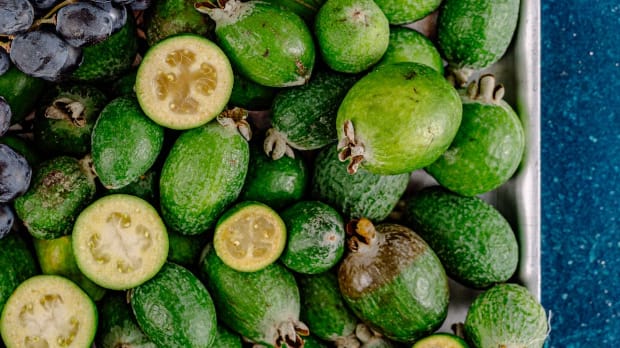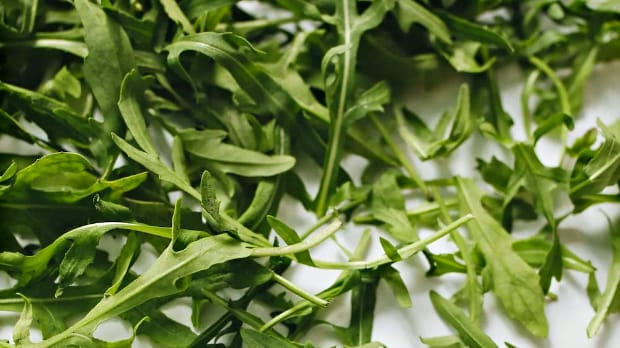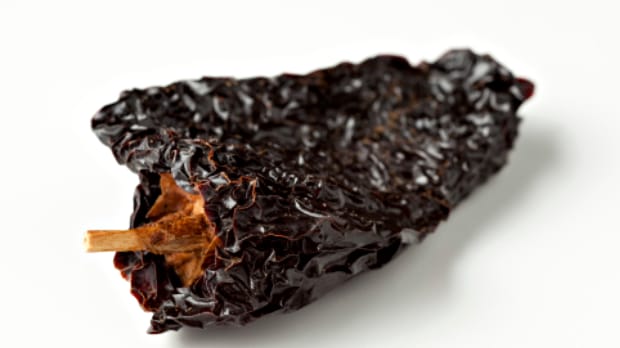What is Feijoa?
Feijoa, pronounced [fay-JO-a], is a fruit that originally belongs to subtropical South America, but is now commercially grown in regions like New Zealand and Northern California. These fruits can be enjoyed during the spring and early summer seasons. Feijoas, also known as pineapple guavas, are aptly named after the delicious, tropical flavor of their creamy-white, juicy, granular flesh. If you bite into this fruit, you will surely experience a heavenly taste that is a perfect combination of pineapple and guava or strawberry, with a mild hint of spearmint.
When you purchase this fruit, make sure to choose the ripe ones that have a full and rich aroma. These fruits should “give” or feel tender to the touch, like a ripe plum or pear, which indicates that they are ready to eat. In case you have unripe feijoas, you can ripen them by enclosing them in a paper bag with an apple at room temperature. This will expedite the ripening process and make them ready to eat.
Once the feijoas are ripened, it’s essential to store them in the refrigerator to extend their shelf life for about a week. These tropical delights can be eaten as a delicious snack or can be used as a key ingredient in a wide range of recipes. Now that you know what feijoas are and how to enjoy them, go ahead and grab some to experience their scrumptious taste for yourself!
What are the Nutritional Benefits of Feijoa?

I am always looking for new ways to introduce my readers to the nutritional benefits of different foods. Today, I want to talk about a fruit that you may not have heard of before – Feijoa! This is a unique and tasty fruit that is native to South America. It is also known as pineapple guava or guavasteen. Feijoa is packed with vitamins, minerals, and fiber, making it a great addition to your diet.
One of the biggest nutritional benefits of feijoa is its high vitamin C content. Vitamin C is an antioxidant that can help to boost your immune system and protect your cells from damage. Feijoa is also a good source of vitamin B6, which is important for brain function and the production of red blood cells.
Another benefit of feijoa is its high fiber content. Fiber is important for digestive health and aids digestion. Additionally, fiber can help to lower cholesterol levels and improve overall heart health. In addition to vitamins and fiber, feijoa also contains potassium, magnesium, and iron. Potassium is important for regulating blood pressure and heart health, while magnesium and iron are important for bone health and the production of energy in the body. So, why not give feijoa a try? It’s a delicious and nutritious addition to your diet that can provide a range of health benefits.

Types Available
If you’re unfamiliar with the exotic fruit called Feijoa, you might be interested to know that there are actually several different types of Feijoa available. Feijoa is a fruit that is native to South America but is also grown in various parts of the world. Some of the most popular varieties of Feijoa include the Early Gem, Mammoth, and Unique. Each type of Feijoa has its own unique characteristics, such as its size and taste profile, so it’s worth giving them all a try to see which one you like best. Whether you’re looking to incorporate Feijoa into your smoothies or salads, there is a type of Feijoa out there that is sure to suit your taste preferences. So, why not give Feijoa a chance and explore the different varieties that are available? You might just discover your new favorite fruit!
What are the Best Uses for Feijoa?
Looking for a new fruit to add to your produce rotation? Look no further than feijoa! This unique and flavorful fruit is packed with nutrients and versatility. One of the best uses for feijoa is to eat it raw, straight off the tree. Its sweet, slightly tart taste will tantalize your taste buds and leave you wanting more. Feijoa can also be used in a variety of dishes, from salads to smoothies.
If you’re feeling adventurous, try baking with feijoa! This versatile fruit can be used in cakes, muffins, and breads for a unique and delicious twist. Whether you’re a seasoned feijoa lover or a newbie to the fruit, there are countless ways to incorporate it into your diet. So go ahead, give feijoa a try and discover its tasty benefits for yourself!
How do You Store Feijoa?
Are you wondering how to properly store those delicious feijoas you picked up at your local farmers market? Well, fear not! Today, I will give you some tips to help keep those fruits fresh and tasty for longer. First and foremost, it is important to note that feijoas are best stored at room temperature until they are fully ripe. Once they are ripe, they can be stored in the refrigerator to help prolong their shelf life.
To determine if your feijoas are ripe, gently press your thumb against the skin. If the fruit gives slightly, it’s ripe and ready to eat. If it feels hard, it needs some more time to ripen.
You can place your feijoas in a paper bag with a banana or apple to speed up the ripening process. This will help release ethylene gas, which is a natural ripening agent. Once your feijoas are ripe, it’s time to store them in the refrigerator. For best results, place them in a plastic bag with some air holes to allow for proper ventilation. Feijoas can last up to two weeks in the fridge, but it’s best to consume them as soon as possible for optimal freshness and taste.
So there you have it! Properly storing your feijoas can help extend their shelf life and keep them fresh for longer. Enjoy those delicious and nutritious fruits!
How to Prepare Feijoa
Feijoa, also known as pineapple guava, is a delightful fruit with a unique taste that has won over many foodies. If you’ve never tried it before, you’re in for a treat! Here’s how you can prepare feijoa: Choose firm and ripe feijoas. They should be slightly soft to the touch and have a sweet fragrance.
Wash the feijoas thoroughly under running water and pat them dry. Then, cut the fruit in half lengthwise. You may notice a jelly-like center; this is completely normal. Scoop out the flesh with a spoon. Avoid eating the skin as it can be tough and bitter. You can eat feijoa raw, or use it as a flavorful addition to smoothies, salads, baked goods, and more.
When is Feijoa in Season?
Are you looking for a new fruit to add to your healthy eating rotation? Look no further than the feijoa! But when is the best time of year to enjoy this refreshing and nutrient-packed fruit? Typically, feijoas are in season in New Zealand during their autumn and winter months. This means you can start enjoying them as early as March and all the way through June. In California, they are usually available from October to December. Keep an eye out for these little guys at your local farmer’s market or grocery store during this time of year.
One reason to love feijoas is their impressive nutritional profile. These fruits are rich in vitamin C, dietary fiber, and antioxidants. Not only can they help boost your immune system and aid in digestion, but they may also play a role in preventing chronic diseases like cancer and heart disease. So whether you enjoy feijoas on their own, in a smoothie, or in a fruit salad, make sure to take advantage of their peak season for maximum flavor and nutrition. Your taste buds – and your body – will thank you!
Improve Your Health With Seasonal Eating
What to Serve Feijoa With?
- Greek yogurt
- Honey
- Baked oatmeal
- Cream cheese
- Muffins
- Granola
- Coconut flakes
- Apple slices
- Ice cream
- Pecans
What Traditional Cuisines Use Feijoa?
Feijoa is a tropical fruit native to South America and is popularly used in Brazilian, Argentinian, Chilean, and Peruvian cuisines. It is used in a variety of dishes, such as salads, smoothies, juices, jams, and desserts. Feijoa is also commonly used to make a traditional Brazilian beverage called caipirinha.
Tasty Recipes
Key Takeaways
- Feijoas can be eaten raw or cooked, and can be used in a variety of recipes such as chutneys, jams, cakes, muffins and pies.
- Feijoas have a unique flavour that is both sweet and tart, and pairs well with other flavours such as ginger, lemon and cinnamon.
- To prepare feijoas, cut them in half and scoop out the flesh using a spoon.
- When selecting feijoas, look for ones that are plump and slightly soft to the touch.
- Feijoas are a good source of vitamin C, fibre and antioxidants.
- To store feijoas, place them in an airtight container in the refrigerator for up to one week.
References: Evaluation of Feijoa Fruit (Acca sellowiana (Berg) Burret): A Review | Feijoa (Acca sellowiana (Berg) Burret): Nutritional and functional properties | Phenolic compounds, antioxidant activity and colour of feijoa (Acca sellowiana (Berg) Burret) fruits | Nutritional Composition and Health Benefits of Feijoa (Acca sellowiana (Berg) Burret)




